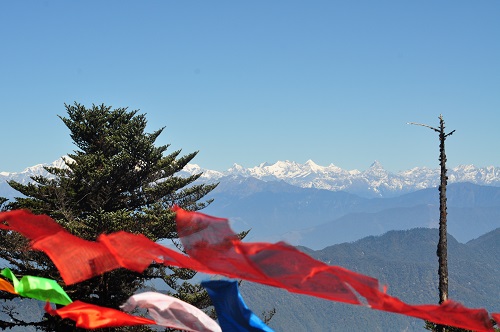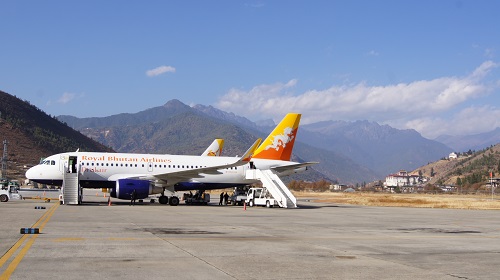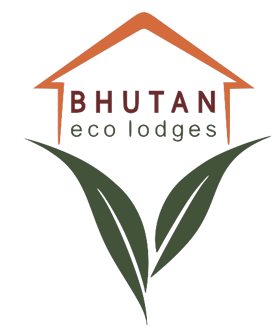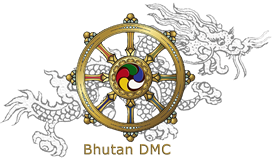Bhutan – the land of happiness!
The Buddhist Kingdom of Bhutan lies along the lofty ridges of the eastern Himalayas, bordering the Tibetan Autonomous region of China in the North and North-West and the Indian states of Sikkim in the West and South-West, Assam in the south, Arunachal Pradesh in the East and South-East and West Bengal in South and South-West. The country within these borders forms a giant staircase, from a narrow strip of land in the south to some of the highest unclimbed Himalayan peaks on earth. With an area of 38,394 square kilometers, Bhutan is comparable to Switzerland both in its size and topography, being largely mountainous.

Wedged between giant neighbours India & China and secluded by some of the highest mountain ranges in the world, it is not surprising that over the long centuries of its history Bhutan remained a land little known to outside world. Even today, the origin of name itself remains obscure. Perhaps it comes from the Sanskrit ‘Bhot ant’ meaning ‘end of Tibet’ or from another Sanskrit word ‘Bhu uttan’ or ‘high land’. The ancient Buddhist writers refer it as Lho Mon or Mon Yul, ‘Paradise of the South’ or the ‘Land of Mons’. To the inhabitants, it is Druk Yul or the Land of Thunder Dragon and it was here that the Drukpa Kagyupa sect of Buddhism came to flower centuries ago.
It was the mighty Himalayas which protected Bhutan from the rest of the world and left the Kingdom blissfully untouched. The Drukpa Kagyupa sect of Mahayana Buddhism provided the essence of a rich culture and fascinating history. The Bhutanese people protected this sacred heritage and unique identity for centuries by choosing to remain shrouded deeply in a jealously guarded isolation.
With a relatively small population of 7,44,000 people, Bhutan enjoy a sustainable lifestyle which they inherited from their forefathers. About 69% population of country still live in small villages sparsely scattered over rugged mountain land. Buddhism, prevalent in the country since the 7th century and continues to play important role in their peaceful lives.
For centuries, Bhutanese have treasured the natural environment and have looked upon it as the source of all life. This traditional reverence for nature has delivered Bhutan into the 21st century with an environment still richly intact. About 72% of the land area is still under forest cover. The country has been identified as one of the ten bio-diversity hot spots in the world and as one of the 221 global endemic bird areas. Its Eco-system harbours some of the most exotic species of the eastern Himalayas with an estimated 770 species of birds and 50 species of rhododendrons, besides an astonishing variety of 300 medicinal plants and orchids. Many parts of the country which have been declared as wildlife reserves, are the natural habitat of rare species of both flora and fauna.

Bhutan is a magnificent land replete with myths and legends. This country of rolling hills and towering crags certainly exudes charm. The mountains are magnificent, the forests are dense, the people are delightful, the air is pure, the architecture inspiring, the religion exciting and the art superb. Like timeless images from the past, the travellers encounters the full glory of this ancient land through its strategic fortresses known as Dzongs, numerous ancient temples, monasteries and stupas which dot the countryside, prayer flags which flutter along the high ridges, wild animals which abound in dense forests, foamy white waterfalls which are the ethereal showers, and the warm smile of its friendly people. Each moment is special as one discovers a country which the people have choose to preserve in its magical purity.
With its beautiful and largely unspoiled Himalayan setting, its rich flora and fauna and its vibrant Buddhist culture, Bhutan has become an increasingly popular destination for international tourists. The Royal Government of Bhutan recognizes that tourism is a world-wide phenomenon and an important means of achieving socio-economic development particularly for developing countries like Bhutan. It also recognizes that tourism, in affording the opportunity to travel, can help in promoting understanding among peoples and building closer ties of friendship based on appreciation and respect for different cultures and lifestyles. Towards achieving this objective, the Royal Government of Bhutan, since inception of tourism in the year 1974, has adopted a very cautious approach to growth and development of the tourism. The Bhutanese tourism industry is based on principle of sustainability that is 'tourism must be environmentally and ecologically friendly, socially and culturally acceptable and economically viable'. Endowed with a rich living culture and pristine natural environment complemented by a development philosophy that espouses balanced growth, Bhutan continues to gain momentum as an emerging high-end destination in South-Asia.
HOTELS IN THIMPHU
HOTELS IN PUNAKHA & WANGDUE
HOTELS IN GANGTEY
HOTELS IN TRONGSA
HOTELS IN BUMTHANG
HOTELS IN MONGAR
HOTELS IN TRASHIGANG
HOTELS IN SAMDRUP JONGKHAR
HOTELS IN PHUENTSHOLING
HOTELS IN HAA
HOTELS IN GELEPHU
HOTELS IN ZHEMGANG
RESTAURANTS IN PARO
RESTAURANTS IN THIMPHU
RESTAURANTS IN PUNAKHA
TOUR ITINERARIES
TREKKING ITINERARIES
SPECIAL INTERESTS TOURS
UNIQUE FESTIVALS & FAIRS
BLOG


